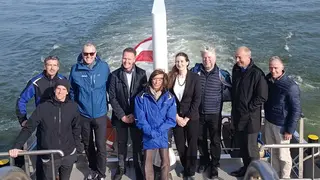In connection with the European transport network TEN-T, the recently appointed European Coordinator for the Rhine-Danube Corridor, Margarida Marques, and her senior advisor, Herbert Pribitzer, paid an informational visit to viadonau on October 20. The day's schedule included a presentation of the company and its areas of responsibility, a trip on a viadonau working vessel, and a demonstration of buoy placement. The program also included a lively exchange of ideas about viadonau's current projects and its innovative and integrative approach to river basin management.
Margarida Marques was appointed European Coordinator for the Rhine-Danube TEN-T corridor on September 12, 2025. She was previously a Member of the European Parliament and Secretary of State for European Affairs, and has held various academic and senior positions at Portuguese universities. The main purpose of the visit on October 20 was to get to know the company viadonau, its role in the trans-European transport network TEN-T, and the wide range of measures being implemented on the Danube. TEN-T is a key EU instrument for establishing a unified, efficient, and high-quality transport network in Europe. It connects railways, roads, waterways, ports, and airports, promotes passenger and freight transport, and strengthens economic and social cohesion within Europe. Since its revision in 2024, it is also focusing more strongly on climate protection, safety, and the resilience of the transport network. As a vital link within this transport network, Europe's second-longest river and, consequently, viadonau as the leading waterway operator on the Danube play a decisive role in this Europe-wide initiative.
Introductory tour to modern waterway development
The day began at viadonau headquarters in Vienna, where the group learned about the company's fundamental tasks in connection with infrastructure development on the Danube, such as waterway maintenance and international coordination of activities in the Danube region. In order to learn about the practical side of waterway development after the theory, the group was then accompanied by project-related employees onto the viadonau working vessel MS Bad Deutsch-Altenburg, which took them from the shore of the town of the same name to the Wildungsmauer mooring place. The trip along the free-flowing stretch east of Vienna was made informative by a demonstration of how to lay a navigation buoy and explanations of the process. The focus was on examples such as the nearby Wildungsmauer mooring place, co-financed by the EU, and numerous renaturation projects along the excursion route, which viadonau has already implemented or is currently implementing. After transferring to a service boat of the Supreme Shipping Authority (Oberste Schifffahrtsbehörde) and arriving at the port of Vienna, the EU coordinator was presented with the “thinkport VIENNA” ideas platform and introduced to Pro Danube Austria, which, as a representative of the business community, emphasized its special focus on sustainable inland waterway transport.
Conclusion: A professional introductory tour focused on inland navigation and waterways, which not only provided the ideal opportunity to once again highlight the important role of the Austrian Danube in the European transport network, but also to intensify the exchange on the future development of the Danube infrastructure. Margarida Marques was impressed by the great commitment, innovative strength, and practical approach of viadonau, emphasizing the importance of international cooperation and joint efforts for safe, sustainable, and future-oriented waterways in Europe.

